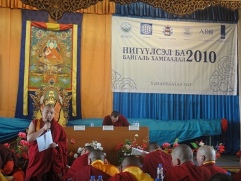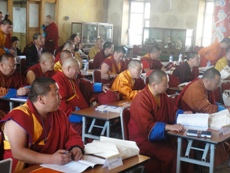Mongolian Buddhists announce first draft of Eight Year Eco Action Plan
May 20, 2010:
 |
 |
 |
Ven.Baasansuren presents a report about his Erdene Zuu monastery's latest eco-projects |
GANDAN MONASTERY, ULAAN BAATAR. Mongolian Buddhists today announced the first draft of a Long Term Plan to protect the environment.
The Eight Year Action Plan will include promoting the use of traditional construction practices for monasteries, providing solar energy to monastic communities, raising public awareness on forest fires, educating young monks and members of the lay community on environmental practices, reducing waste, and looking for the ancient ecological teachings that can be found in the ancient sutras which were hidden during the 60 years of communist rule last century.
This first version of the Eight Year Plan was discussed by an assembly of some 55 lamas and nuns from all over the country at Gandan monastery yesterday, and was then agreed in principle at a follow-up meeting held in the Terelj National Park, just two hours away from Ulaan Baatar. The monks and nuns were attending the Second Compassion and Conservation Conference, hosted by the Gandantegchinlin Monastery and organised by the Tributary Fund with the assistance of the Alliance of Religions and Conservation (ARC), the World Bank, the Government of the Netherlands and the Mongolian Buddhist community.
Many of the monks - who came from all 21 Mongolian aimags, or districts - intend to return to their monasteries and come up with a full draft of an Eight Year Plan within the next 12 months, with the first draft to be submitted by the beginning of July. Link here
for our latest blog.
Context of the Mongolian PlanIt is the latest in a series of commitments by faiths around the world to protect the environment, as part of the ARC/UNDP programme to find ways to incorporate care for the environment into how believers around the world act and work and think, for generations to come. The UN has called it “the biggest civil society movement to prevent climate change.”
The first 30 plans – made by a variety of traditions from nine major world faiths - were launched and announced at Windsor Castle in November 2009, by Prince Philip, founder of ARC, and the Secretary-General of the United Nations, Ban Ki-moon, in advance of the Climate Change Summit in Copenhagen the following month.
 |
 |
 |
Mongolian monks debate their Eight Year Plan to protect the living planet |
For the Baha’is, Daoists, Hindus, Jews, Muslims, Shinto and Sikhs a single overarching plan was created, with various traditions and communities taking it and adapting it for their own needs. The Buddhists and Christians took a different approach, with each tradition creating a plan that would be special to itself. Although only one Buddhist plan was launched at Windsor – by the Shanghai Buddhists, who plan to roll out their initiatives throughout China, and who had their China launch last month – this Mongolian plan is the second.
What People Have Said“The Buddhist philosophy teaches that conservation and the environment are the keys to living life in a Buddhist way,” said His Holiness, Choijamts, Khamba Lama of Gandantegchenling Monastery in a message.
“Instead of trying to come up with new ideas and methods to fight against the world climate change, it is important to guide people’s interaction with nature to the right path,” said Minister of Nature, Environment and Tourism, L Gansukh. “If the ideas presented at this workshop become reality, it would definitely be praiseworthy.”
What is included in the Plan?The key points so far are:
• Monks will be tasked to research and study the traditional construction practices of monasteries. They will then use these for new and renovated buildings, and teach their finding to others.
• A century ago there were taboos in certain sacred places in Mongolia which included avoiding digging in certain places, not polluting rivers, cutting trees, not destroying grass roots nor disturbing nests or killing animals unnecessarily. During their ceremonies at sacred sites monks will revisit some of these, and educate the community about the traditional environmental practices.
• Monastic fortune tellers will encourage people to rehabilitate threatened environments, plant trees and clean river sites to improve their fortunes.
• The traditional practice of liberating animals as an act of compassion will be revived.
• Blue silk khadag scarves are often offered to mountain spirits and left on ovoos, or stone piles. The problem is that when tied around living trees they can stifle their growth, and they last for many years in the countryside. Monks will advocate biodegradeable khadags and collaborate with shopkeepers, media and others on conveying messages to communities.
• Monks will continue to look for the sacred texts or sutras about the environment, many of which were lost under communism. Now, of Mongolia’s 600 plus sacred sites in Mongolia, at least 280 have rediscovered their own associated sutras. The monks believe that more might be found. Monks will collect them, publish them in modern Mongolian and talk to the relevant local communities about what they mean.
Monasteries and temples will be encouraged:
• To develop their own special Eight Year Action Plan and share it with their communities.
• To save energy and water, and monitor their consumption.
• To provide solar energy.
• To set up an Environmental Office or appoint a staff member for nature protection.
• To invite specialists to conduct training on specific environmental issues to the lamas and volunteers.
• To continue to expand community gardens and green sites around monasteries.
• To train young monks, schoolchildren and university students on nature protection and ecology.
• To raise public awareness on traditional environmental practices, forest fires and other environmental impacts caused by human factors.
• When organising public events, to create a garbage point, recycle or process garbage afterwards, and remind the organising institutions about the importance of proper garbage management.
• To advocate reduction of plastic bags and bottles.
• To use their media outlets. For example Gandantegchinlin Monastery will broadcast its efforts and outcomes via its FM radio station.
Some other areas that the monks might be considering over the next few months include:
- how to protect land against the constant incursions by polluting mining companies
- how to protect Mongolia’s rivers and water courses
- introducing an auspicious day of environmental celebration every year
- planting trees, learning which species to plant where, and learning how to look after the seedlings as they grow
- teaching leadership to local communities
- working with herders
- promoting free range eggs and poultry as an extension to the pledge to liberate captive animals.
- examining the pros and cons of vegetarianism, following the example of His Holiness the Karmapa, head of the Tibetan Kagyu sect, who turned vegetarian three years ago, along with thousands of his followers. Currently the monks traditionally spend some 36 days a year as vegetarians (the first, eighth and 15th days in the lunar month) and plan - as part of the Eight Year Plan - to build on this, and explain the merits of vegetarianism to young monks and to their followers.
- making pilgrimages to the Indian city of Bodhgaya – where the Buddha was enlightened, taught, and died - into green pilgrimages
- in accordance with the Mongolian President’s National Day of Planting Trees to choose an auspicious day to plant trees around their temples.
- discouraging illegal hunters from killing the sacred deer on Mongolia’s mountains
Further notesA number of national TV and radio stations in Mongolia covered the event, and it featured on the 9 o’clock news.
Cambodian Buddhists are also looking to create a long term ecological plan, and the Kagyu sect of Buddhists, under the Karmapa, have recently created a similar parallel programme titled “108 Things You Can do to Protect Nature.”
|

